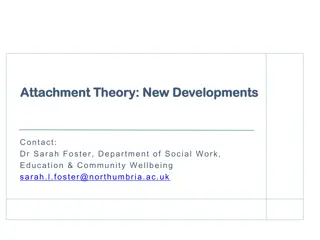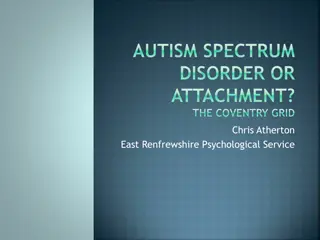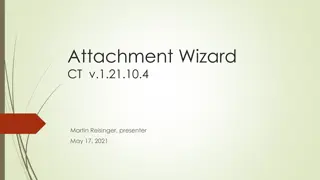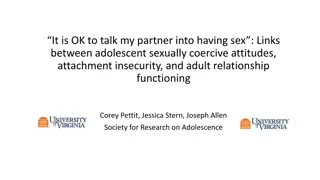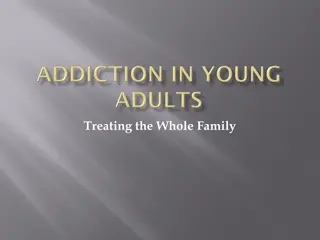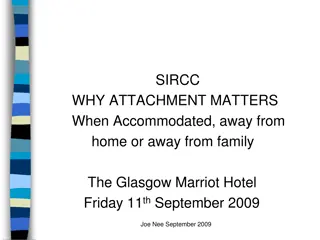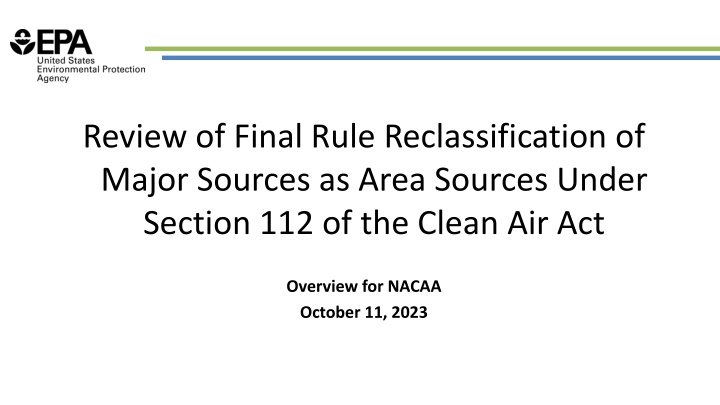
Reclassification of Major Sources under Clean Air Act: Overview & Framework
This review delves into the history and policy changes on reclassifying major sources as area sources under Clean Air Act Section 112. It discusses the Major MACT to Area (MM2A) policy, Executive Order 13990 directives, and the current MM2A framework allowing for reclassification based on emission thresholds. The proposal for additional reclassification conditions is also highlighted.
Download Presentation

Please find below an Image/Link to download the presentation.
The content on the website is provided AS IS for your information and personal use only. It may not be sold, licensed, or shared on other websites without obtaining consent from the author. If you encounter any issues during the download, it is possible that the publisher has removed the file from their server.
You are allowed to download the files provided on this website for personal or commercial use, subject to the condition that they are used lawfully. All files are the property of their respective owners.
The content on the website is provided AS IS for your information and personal use only. It may not be sold, licensed, or shared on other websites without obtaining consent from the author.
E N D
Presentation Transcript
Review of Final Rule Reclassification of Major Sources as Area Sources Under Section 112 of the Clean Air Act Overview for NACAA October 11, 2023
Outline Regulatory History of Reclassifications in the National Emissions Standards for Hazardous Air Pollutants (NESHAP) Program Overview of Proposed Requirements Next Steps 2
Clean Air Act section 112 Major and Area Sources Major Sources: any stationary source or group of stationary sources located within a contiguous area and under common control that emits or has the potential to emit considering controls, in the aggregate, 10 tons per year or more of any hazardous air pollutant or 25 tons per year or more of any combination of hazardous air pollutants Area Sources: any stationary source of hazardous air pollutants that is not a major source 3
History of Reclassifications 1995 Once in Always In (OIAI) Policy Sources could not reclassify after the first substantive compliance date of a major source NESHAP Policy laid out through a memorandum 2018 Major MACT to Area (MM2A) Policy Sources could reclassify from major source to area source at any time Policy laid out through a memorandum 2020 MM2A Rulemaking Codified the 2018 policy through notice and comment rulemaking Executive Order 13990 January 20, 2021 EO directed EPA to identify actions from the prior few years that should be reviewed, revised, or rescinded. 2020 MM2A rulemaking identified under EO 13990 ADD A FOOTER 4
Current MM2A Framework Sources can reclassify from major source status to area source status at any time by limiting their emissions and potential to emit (PTE) below the major source thresholds (10 tons per year individual HAP or 25 tons per year total HAP) Sources that were previously emitting well below the major source thresholds can reclassify and potentially emit up to the major source thresholds, depending on applicable area source requirements 5
September 27, 2023 Proposal Proposed review of 2020 final MM2A rule adds conditions for reclassification. Safeguards o Upon reclassification, sources must continue to limit emissions to what was allowed under the previous major source NESHAP by either: Continuing to meet the same emissions limits that were in place prior to reclassification; or Comply with subpart-specific requirements for reclassified sources in a category; or Comply with emission standards that a source demonstrates to permit authority are at least as stringent as previously applicable major source limits Federal Enforceability o Limits taken to reclassify from major source status to area source status must be federally enforceable. Enforceable by the Administrator and citizens under the CAA or other Federal statute 6
Who Does This Apply To? Any Sources that have reclassified since January 25, 2018 Requesting comments on: Whether these requirements should only apply moving forward from effective date of final rule? How long sources that have already reclassified should be given to comply? How long sources that reclassify in the future should be given to comply? 7
Next Steps Proposed rule published in the Federal Register on September 27, 2023 (88 FR 33636) 45 day public comment period (ends November 13, 2023) Docket: EPA-HQ-OAR-2023-0330 Target final rule signature in mid-May 2024 Anticipating OMB interagency review of final rule (up to 90 days) prior to final rule signature ADD A FOOTER 8
Questions? Nathan Topham topham.nathan@epa.gov 919-541-0483


